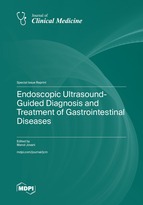Endoscopic Ultrasound-Guided Diagnosis and Treatment of Gastrointestinal Diseases
A special issue of Journal of Clinical Medicine (ISSN 2077-0383). This special issue belongs to the section "Gastroenterology & Hepatopancreatobiliary Medicine".
Deadline for manuscript submissions: closed (21 August 2023) | Viewed by 21937
Special Issue Editor
Special Issue Information
Dear Colleagues,
It is with great pleasure that I invite you to contribute to this exciting Special Issue on “Endoscopic Ultrasound-Guided Diagnosis and Treatment of Gastrointestinal Diseases”.
The endoscopic ultrasound (EUS) started as a simple diagnostic methodology nearly five decades ago, and has since become an indispensable tool for the diagnosis and management of numerous gastrointestinal pathologies.
As a diagnostic tool, the EUS has become an integral component of the staging of gastroesophageal and biliopancreatic neoplasia, histologic sampling of upper and lower gastrointestinal lesions/periluminal masses, screening of pancreatic cancer, and, more recently, of the development of the new field of endo-hepatology. New accessories have been invented or improved upon, significantly increasing the diagnostic yield of the EUS, including the introduction of new types of needles and an increased utilization of elastography and the contrast-enhanced EUS. Artificial intelligence has seen a dramatic increase in utilization in luminal endoscopy, and new models of AI are currently being applied to EUS to further increase its diagnostic capabilities.
Considering that with the EUS transducer we can easily access organs adjacent to the gastrointestinal tract, it was simply a matter of time before EUS became interventional, as it did in the early 1990s. Since then, the scope and range of EUS-guided interventions has dramatically increased, extending from EUS-assisted rendez-vous ERCP, EUS-guided celiac plexus block/neurolysis and fiducial placement, EUS-guided biliary and pancreatic drainage—both in regular and altered anatomy— to the treatment of cysts and solid lesions in the pancreas/liver with EUS-guided local therapies (such as the EUS-guided injection of antitumoral agents/immunotherapy or EUS-guided ablative techniques), EUS-guided coiling/glue injection for gastric varices, and EUS-guided drainage of abdominopelvic collections. The introduction of lumen-apposing metal stents (LAMS) revolutionized the therapeutic capabilities of EUS, by allowing the creation of new gastrointestinal anastomoses. This, in turn, made possible interventions that previously were a part of the surgical or interventional radiology realm, such as EUS-guided cystogastrostomy (EUS-CG)/endoscopic necrosectomy, EUS-guided gastroenterostomy (EUS-GE), EUS-guided gallbladder drainage (EUS-GD), EUS-directed transgastric ERCP (EGDE), and EUS-directed transenteric ERCP (EDEE), etc.
These and many other tremendous advances, too many to enumerate in a short paragraph, make diagnostic and therapeutic EUS a very exciting field. However, evidence for much of what is performed in clinical practice is usually of poor quality, based often on retrospective studies or expert opinion, leaving many questions unanswered. Many projects are currently ongoing, aiming to provide much-needed evidence, including the utility of new technologies and accessories to increase the diagnostic yield of EUS, as well as the development of dedicated specialized accessories and the standardization of procedures for therapeutic EUS.
This Special Issue of the JCM journal is dedicated to the publication of articles answering some of these questions and reviewing the available evidence for diagnostic and therapeutic EUS techniques. I am sure that you will join me in my enthusiasm for this extremely exciting project and I look forward to receiving your contributions.
Dr. Manol Jovani
Guest Editor
Manuscript Submission Information
Manuscripts should be submitted online at www.mdpi.com by registering and logging in to this website. Once you are registered, click here to go to the submission form. Manuscripts can be submitted until the deadline. All submissions that pass pre-check are peer-reviewed. Accepted papers will be published continuously in the journal (as soon as accepted) and will be listed together on the special issue website. Research articles, review articles as well as short communications are invited. For planned papers, a title and short abstract (about 100 words) can be sent to the Editorial Office for announcement on this website.
Submitted manuscripts should not have been published previously, nor be under consideration for publication elsewhere (except conference proceedings papers). All manuscripts are thoroughly refereed through a single-blind peer-review process. A guide for authors and other relevant information for submission of manuscripts is available on the Instructions for Authors page. Journal of Clinical Medicine is an international peer-reviewed open access semimonthly journal published by MDPI.
Please visit the Instructions for Authors page before submitting a manuscript. The Article Processing Charge (APC) for publication in this open access journal is 2600 CHF (Swiss Francs). Submitted papers should be well formatted and use good English. Authors may use MDPI's English editing service prior to publication or during author revisions.
Keywords
- pancreatobiliary disease
- diagnostic EUS
- contrast-enhanced EUS
- endo-hepatology
- interventional EUS
- EUS-guided biliary and pancreatic drainage
- EUS-guided local therapies
- lumen-apposing metal stents
- new technologies
- artificial intelligence







